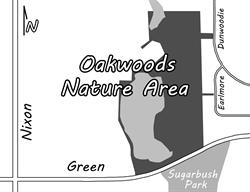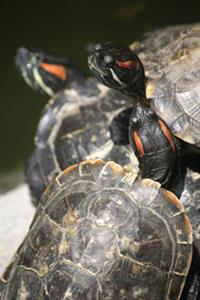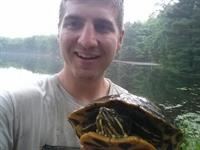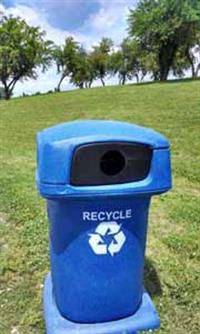Natural Area Preservation News
Protecting and restoring Ann Arbor's natural areas and fostering an environmental ethic among its citizens.
Volume 19, Number 3
Autumn 2014
Park Focus: Oakwoods
Michael Hahn
The first time I ventured to Oakwoods Nature Area, my immediate thought was, “How impressive could this place be? It’s surrounded by houses!” Nestled in the Arbor Hills neighborhood on the northeast side of town, Oakwoods has three entrances, two of which are unassuming, tucked between houses on Dunwoodie Road and Earlmore Lane. The third access point is located off of Green Road - a slightly more conspicuous entrance than those found in the neighborhood.
Upon entering the woodland my attention was caught by the subtlety of rolling hills covered by mature oak and hickory trees. I followed a trail to the east, making my way to the top of a hill. At its crest, I was welcomed with a beautiful view overlooking a small pond tucked in between the understory trees and shrubs. As I hiked down and around a few curves in the trail, crossing a corduroy-style bridge, two mallard ducks dropped down to the water from the sky. They were so focused on making it to their landing spot that they never even noticed me standing there watching them. The ducks began dabbling in the water, foraging for food, and it was at this point that I understood the importance of Oakwoods.

Oakwoods is a 22-acre oak-hickory woodland, with several small ponds bordered by a large wetland to the west. Because of its diverse habitat of upland forest, ponds, and wetlands, this nature area can support a wide variety of different plant and animal species, making it a great place to view wildlife. During the early spring you might be lucky enough to see salamanders emerging from their winter hibernation, waddling across the landscape towards the water to reproduce. At ground level one can find a brilliant display of wildflowers, with the sounds of Spring Peepers and other tree frogs calling in the background. As the seasons progress, sedges create an almost carpet-like appearance on the forest floor. However, what I found most interesting while hiking around this impressive woodland was the diversity of trees. There are oaks, hickories, ironwood, beech and basswood present. Even more, there is an outstanding difference in the age of trees. You’ll find a display of old trees, saplings, seedlings and everything in between - all of which will make a wonderful exhibit of fall colors.
If I’ve learned one thing while working in the ecological restoration field, it is that restoration is a process, not a result. For the past 18 years, volunteers and staff have been working diligently at Oakwoods to achieve our restoration goals. The first documented work was back in January, 1996 cutting buckthorn, and over the subsequent months further progress was made by removing more invasive brush. The first controlled burn was conducted a couple of years later, in the spring of 1998. Today, those restoration efforts are evident throughout the park. I am excited to see how Oakwoods changes as we continue our restoration efforts in the years to come.
Coordinator's Corner: Yellowstone
David Borneman, Deputy Manager for Volunteerism and Natural Area Preservation
Years ago, shortly after I began working for NAP, a friend from out west stopped by for a visit and to see our work here in the City parks. Himself a wildland firefighter with the National Park Service, he had personally participated in prescribed burns thousands of times bigger than anything NAP would ever do. So I remember feeling a little silly showing him the results of a tiny 2-acre burn, knowing that he was used to working in national parks, restoring enormous landscapes that protect grizzlies and wolves, not in tiny city parks.
But my friend pointed out something that I hadn’t fully considered before, though it was obviously true: The only way that there will be any support for protecting and restoring large, intact ecosystems far away is if people can see and experience such stewardship efforts at a local level, in their backyards. Perhaps getting the public comfortable with prescribed fire in city parks helps them also feel comfortable seeing it introduced into national parks. And perhaps it is easier to understand controversies surrounding the reintroduction of predators like wolves into national parks, if one has already personally dealt with neighbors upset about having coyotes move into their local city park.
I reflected on these things this summer when I had the opportunity to take my kids on their first trip to Yellowstone National Park. We saw wolves, bears, elk, and many other animals that are only a far distant memory to the Ann Arbor area. The wildlife roamed freely across an enormous uninterrupted ecosystem, the likes of which is hard to imagine ever existed here in southeastern Michigan. It is incredibly important that we save places like Yellowstone where there is still wilderness. We need to keep those areas wild, which means we need to keep them “out there,” far away from where most of us live. I will never visit most of these remote wilderness areas, but I don’t need to, and I wouldn’t want the infrastructure built that would facilitate too much visitation from the public. That’s one of the important functions of our local natural areas, to give us nearby places where we can jump in and get our hands dirty and grapple with issues like invasive species and fire suppression and predator-reintroduction - where we can learn to be good stewards. We can work out our environmental ethic right here in the city parks. And that ethic will then guide our policies regarding remote wilderness areas that few of us will ever visit.
I invite you to take advantage of this opportunity. What you do here in your local city parks may very well influence what happens in our largest national parks and wilderness areas. You really do have the opportunity to “think globally, act locally.” Don’t miss it!
Michigan's Red-Eared Slider
If you have been boating at Gallup Park recently, you may have noticed large wooden poles jutting out of the water with traps suspended between them. This is an effort lead by NAP’s Herpetologist, Patrick Terry, to understand the health of Gallup Park's turtle community. Patrick is also gathering data for his master's research on a turtle with a controversial history in Michigan, the Red-eared Slider.
 photo: Laszlo Ilyes
photo: Laszlo Ilyes
The Red-eared Slider is an aquatic turtle often found in Ann Arbor's natural areas and throughout Michigan's Lower Peninsula. Most biologists consider this turtle to occur naturally from the southeastern United States to the fringes of southwest Michigan, making its status as native or non-native to Michigan a topic of debate. This is largely due to the turtle's popularity in the pet trade, which has allowed it to become introduced worldwide. Many supporters of the species’ non-native origin believe it has become established in Michigan through the repeated release of unwanted pets. On the other hand, proponents of the native origin think that the turtle has been a part of Michigan for a long time and has expanded its range naturally during a brief warming stage in the last glacial period approximately 2,500-9,000 years ago. Both sides are backed by a good deal of circumstantial evidence; however, until the availability of recent genetic testing, performing an experiment has not been possible.
 By taking DNA samples from captured turtles, Patrick will be able to compare each genetic sample to those that have been collected elsewhere in the United States. If Michigan’s Red-eared Sliders are native, they should be more genetically similar to populations that are geographically closer, such as those in Indiana. If the opposite is observed, it would indicate that the turtles have been introduced to the state by humans. It is entirely likely, however, that the history of Michigan's Red-eared Slider is more complex than a simple native or non-native origin and that each population has a unique past. Whatever the result, the Red-eared Slider will still be a beneficial species to our aquatic ecosystems and will continue to be protected.
By taking DNA samples from captured turtles, Patrick will be able to compare each genetic sample to those that have been collected elsewhere in the United States. If Michigan’s Red-eared Sliders are native, they should be more genetically similar to populations that are geographically closer, such as those in Indiana. If the opposite is observed, it would indicate that the turtles have been introduced to the state by humans. It is entirely likely, however, that the history of Michigan's Red-eared Slider is more complex than a simple native or non-native origin and that each population has a unique past. Whatever the result, the Red-eared Slider will still be a beneficial species to our aquatic ecosystems and will continue to be protected.
NAPpenings: Welcome, New Park Stewards!
- David Repp and Richard Geglio - White Oak Nature Area
- Leonore Gerstein - Oakridge Nature Area
- Margot Mehringer - Bird Hills Nature Area
NAPpenings: Thank You!
Many thanks to the groups who volunteered with NAP recently. We could not make such a difference without you!
- Ann Arbor Academy
- Arbor Prep
- Community High School
- Emerson School
- Greenhills School
- King School
- KT’s Running Group
- Office of Health Equity and Inclusion
- The North Face
- Toyota Boshoku
- Triangle Fraternity
- UM Law School
- WATT Youth Day of Caring
- Yoga Serves
- Youth Volunteer Corps- Ann Arbor YMCA
NAPpenings: Recycling at Ann Arbor Parks!
 Recycle Ann Arbor has partnered with the City of Ann Arbor’s Solid Waste Division and the City of Ann Arbor’s Parks & Recreation Department to introduce recycling options for the Ann Arbor community and park users at 14 pilot parks!
Recycle Ann Arbor has partnered with the City of Ann Arbor’s Solid Waste Division and the City of Ann Arbor’s Parks & Recreation Department to introduce recycling options for the Ann Arbor community and park users at 14 pilot parks!
Staff Updates: Welcome...
 Mike Hahn, Stewardship Specialist
Mike Hahn, Stewardship Specialist
For the past eight years I managed natural areas and coordinated volunteers for a land trust in the Chicagoland area. My passion for ecological restoration is continually growing and I am eager for the opportunity to share that passion with the residents of Ann Arbor. I hope to see you in the field!
 Kristen Schotts, Field Crew
Kristen Schotts, Field Crew
I have always been passionate about the environment and working to restore it. After interning with the field crew, I am excited to join the team as an official member. I look forward to helping others have fun taking care of the environment.
 Rachel Weston, Field Crew
Rachel Weston, Field Crew
After working for a plant ecology lab as well as UM’s Matthaei Botanical Gardens and Nichols Arboretum, I wanted to continue working to restore natural areas within the city. I am excited to work with NAP and to interact with Ann Arbor’s wonderful residents!
 Dana Burnette, Park Steward Coordinator
Dana Burnette, Park Steward Coordinator
I fell in love with ecological restoration after participating in a prescribed burn, and I have experiences teaching environmental education to youth, square-foot gardening in Fiji, and sampling fish on Lake Huron with NOAA. I’m excited to work with NAP’s dedicated volunteers!

Mary Adams, Workday Coordinator
I am interested in connecting people to nature, and I want to help volunteers become engaged and excited about preserving the local parks. I am very excited to get started at NAP and to learn more about Ann Arbor’s natural areas!
Staff Updates: Farewell...
 Ashley Schilling, Field Crew
Ashley Schilling, Field Crew
Over the past year with NAP I have enjoyed getting to know Ann Arbor’s beautiful natural areas and dedicated volunteers. While time at NAP is coming to a close, I am happy to say that I will be still be close by working for a local controlled burn company while finishing my degree.
 Jessica Crawford, Workday Coordinator
Jessica Crawford, Workday Coordinator
Although I was Workday Coordinator for a short time, I was fortunate to have worked along side some dedicated and amazing people at NAP and with the awesome volunteers who came out rain or shine! Although I am no longer in Ann Arbor, I hope to come back and visit these great natural areas!
Staff Updates: Congratulations...
 Outreach Communications and Events Coordinator, Renée Hytinen, and her husband Dave, welcomed their second son, Isaac Nilson, on June 28th, 2014. Everyone is healthy and happy and adjusting well.
Outreach Communications and Events Coordinator, Renée Hytinen, and her husband Dave, welcomed their second son, Isaac Nilson, on June 28th, 2014. Everyone is healthy and happy and adjusting well.
Annual Volunteer Appreciation Potluck!

Wednesday, Oct. 22, 6:30 - 9:30 p.m.
Cobblestone Farm
All volunteers are invited to our annual celebration of your volunteerism and stewardship!
RSVP by Oct. 17 to [email protected] or 734.794.6627
